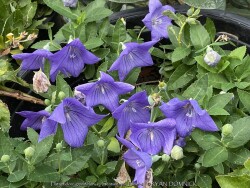

***Description for this perennial available with future update!***Dwarf Blue Balloonflower, is also known as Platycodon grandiflorus 'Sentimental Blue'
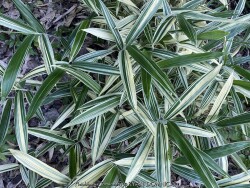

***Description for this grass available with future update!***>>>>>To keep bamboo from spreading into other landscape or formal lawn areas, you must install a continuous border around the grove.
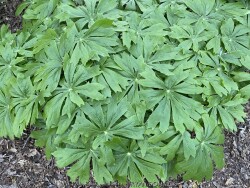

Mayapple (Podophyllum peltatum) is a spring growing perennial with large green umbrella like leaves. White five petal flowers appear on mature plants with green "apple-like" fruits to follow. Mayapple is native to rich woodland areas in Kansas, the Midwest, and most of the eastern United States; it needs rich well-drained soils. Mayapple colonizes by rhizomes forming dense slow-spreading mats making this an easy plant to spot from a distance especially in the early spring. Early spring emergence is normally not a problem as foliage resists normal spring frosts. During the April deep freeze of 2007 in Lawrence, KS, temperatures bottomed out at 18°F after an extra warm March. As a comparison, hosta foliage had completely unfurled was killed to the ground but Mayapple foliage had no damage for several days of the cold blast with temperatures down to 22-24°F! Moderate damage occurred on the last night at 18°F but no long term problems persisted. After summer heat and drought sets in usually by mid June, the foliage disappears completely going dormant until the next spring. Because it goes dormant, summer drought is usually not a problem as long as soil is rich in organic matter and moisture-retentive. Fruit-set is uncommon as vegetative growth is the primary method of propagation. A single-leafed stem will not produce a flower that season. A forked stems bearing two leaves will have a tight flower bud nestled at the base of the two petioles and possible fruit if pollinated. Bees seem to do this work, especially queen bumble bees. Blooms occur at a time of year when other pollen sources are rare thus being very valuable for wild-life. Fruit is sweet and edible, however with caution. Usually one or two fruits is safe but toxic if eaten in larger quantities. Usually, raccoons or possums get to the fruit before humans. This native perennial gives a tropical vibe and is valuable for the early spring foliage, flower, and fruit but be prepared for a bare spot during the rest of summer unless you fill in with summer annuals, late emerging perennials, or mulch to stop weed growth.


***Description for this perennial available with future update!***Chinese Mayappple >>>>> ***Description for this perennial available with future update!***
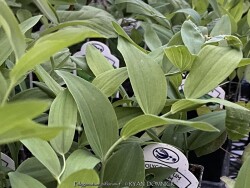

Solomon Seal (Polygonatum sp.) is a very large genus of perennials comprising dozens of species. Many of the species that are appropriate for garden use in Kansas are native to seasonally dry to moist forests in North America and Asia. New growth arises each year from a finger-like slowly spreading rhizome system. The foliage has a central stem with architecturally arranged opposite leaves covering the length of the stem gradually getting smaller towards the end. Small bell-shaped white flowers appear in early spring followed by bluish-purple fruit. Flowers and new spring growth is frost-hardy. Most Solomon seals do well with average garden soils and moisture with many tolerating dry-shade well. Solomon's seal can grow for many years increasing in density without ever needing division. Over time this creates a nearly weed-proof groundcover. in eastern Kansas with 40 inches of rain per year on average, there seems to be plenty of moisture to create extremely healthy patches of Solomon seal that compete well with tree roots. While some species can tolerate sun, there are many better choices as sunburning will likely occur with afternoon sun in temperatures over 95 degrees F. Combine with hostas or other shade plants to create a dramatic effect. Included in our "edibles" database but depends on how hungry you are! Polygonatum biflorum, also known as Smooth solomon's-seal, is native to Kansas and Central U.S. forests in average to moist conditions including dry-shade. It adds a bright splash of light green to the shade garden. Fruiting does occur and desirable self-seeding occurs within the patch. Plants reach heights of 18-24" tall in Kansas. Fall color is a brilliant yellow for a week before going dormant. Maintenance is easy as stems easily detach when raking with fall clean-up. If cosmetic foliage leaf-rust is a problem, just cut back early. During the April deep freeze of 2007, temperatures bottomed out at 18°F after an extra warm March. Hosta and Solomon seal foliage had completely unfurled and was flowering. All hostas were killed to the ground but solomon seal foliage and flowers survived un-damaged! A great "Once it's there, it's there forever" plant for dry-shade!
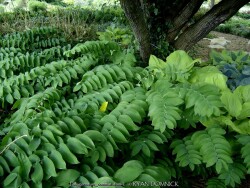

Solomon Seal (Polygonatum sp.) is a very large genus of perennials comprising dozens of species. Many of the species that are appropriate for garden use in Kansas are native to seasonally dry to moist forests in North America and Asia. New growth arises each year from a finger-like slowly spreading rhizome system. The foliage has a central stem with architecturally arranged opposite leaves covering the length of the stem gradually getting smaller towards the end. Small bell-shaped white flowers appear in early spring followed by bluish-purple fruit. Flowers and new spring growth is frost-hardy. Most Solomon seals do well with average garden soils and moisture with many tolerating dry-shade well. Solomon's seal can grow for many years increasing in density without ever needing division. Over time this creates a nearly weed-proof groundcover. in eastern Kansas with 40 inches of rain per year on average, there seems to be plenty of moisture to create extremely healthy patches of Solomon seal that compete well with tree roots. While some species can tolerate sun, there are many better choices as sunburning will likely occur with afternoon sun in temperatures over 95 degrees F. Combine with hostas or other shade plants to create a dramatic effect. Included in our "edibles" database but depends on how hungry you are! Polygonatum commutatum, also known as Great Solomon's seal, is native to Eastern U.S. forests in average to moist conditions. It adds a bright splash of light green to the shade garden. Fruiting does occur and desirable self-seeding occurs within the patch. Plants reach heights of 24-36" tall in Kansas. Fall color is a brilliant yellow for a week before going dormant. Maintenance is easy as stems easily detach when raking with fall clean-up. If cosmetic foliage leaf-rust is a problem, just cut back early. During the April deep freeze of 2007, temperatures bottomed out at 18°F after an extra warm March. Hosta and Solomon seal foliage had completely unfurled and was flowering. All hostas were killed to the ground but solomon seal foliage and flowers survived un-damaged! A great "Once it's there, it's there forever" plant for dry-shade!
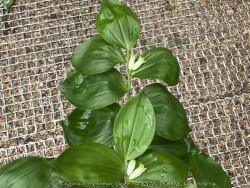

Solomon Seal (Polygonatum sp.) is a very large genus of perennials comprising dozens of species. Many of the species that are appropriate for garden use in Kansas are native to seasonally dry to moist forests in North America and Asia. New growth arises each year from a finger-like slowly spreading rhizome system. The foliage has a central stem with architecturally arranged opposite leaves covering the length of the stem gradually getting smaller towards the end. Small bell-shaped white flowers appear in early spring followed by bluish-purple fruit. Flowers and new spring growth is frost-hardy. Most Solomon seals do well with average garden soils and moisture with many tolerating dry-shade well. Solomon's seal can grow for many years increasing in density without ever needing division. Over time this creates a nearly weed-proof groundcover. in eastern Kansas with 40 inches of rain per year on average, there seems to be plenty of moisture to create extremely healthy patches of Solomon seal that compete well with tree roots. While some species can tolerate sun, there are many better choices as sunburning will likely occur with afternoon sun in temperatures over 95 degrees F. Combine with hostas or other shade plants to create a dramatic effect. Included in our "edibles" database but depends on how hungry you are! Hidden Flower Solomon's Seal (Polygonatum cryptanthum 'Crug') is one of the most attractive solomon seals in our display garden. This species forms a tight clump of slow-spreading rhizomes with bubbly, shiny green foliage 12" tall. Stems feature rows of small, white, clustered bells that do not open fully and are attached just below the leaf intersections. Brilliant blue fruit ripens late summer and fall. Fall color is a brilliant yellow for a week before going dormant. Maintenance is easy as stems easily detach when raking with fall clean-up. If cosmetic foliage leaf-rust is a problem, just cut back early. A great "Once it's there, it's there forever" plant for dry-shade! Rarely available for sale as propagation is slow.
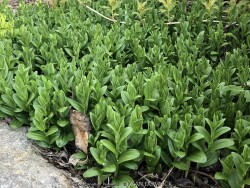

Solomon Seal (Polygonatum sp.) is a very large genus of perennials comprising dozens of species. Many of the species that are appropriate for garden use in Kansas are native to seasonally dry to moist forests in North America and Asia. New growth arises each year from a finger-like slowly spreading rhizome system. The foliage has a central stem with architecturally arranged opposite leaves covering the length of the stem gradually getting smaller towards the end. Small bell-shaped white flowers appear in early spring followed by bluish-purple fruit. Flowers and new spring growth is frost-hardy. Most Solomon seals do well with average garden soils and moisture with many tolerating dry-shade well. Solomon's seal can grow for many years increasing in density without ever needing division. Over time this creates a nearly weed-proof groundcover. in eastern Kansas with 40 inches of rain per year on average, there seems to be plenty of moisture to create extremely healthy patches of Solomon seal that compete well with tree roots. While some species can tolerate sun, there are many better choices as sunburning will likely occur with afternoon sun in temperatures over 95 degrees F. Combine with hostas or other shade plants to create a dramatic effect. Tiny Green Solomon's Seal (Polygonatum humile) is a miniture groundcover solonons seal only 4-8" tall. This cute plant is everything "solomon seal" just miniture! Best growth occurs in average to wet soils in part shade to full shade. Slowly spreading thin rhizomes form a colony in optimum growing conditions. In dry shade, the plant survives but goes dormant by mid-summer paving the way for weeds to come in so avoid these conditions.
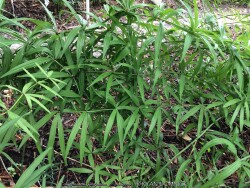

Solomon Seal (Polygonatum sp.) is a very large genus of perennials comprising dozens of species. Many of the species that are appropriate for garden use in Kansas are native to seasonally dry to moist forests in North America and Asia. Orange Flowering Climbing Solomon's Seal (Polygonatum kingianum / huanum) is definitely not typical of the genus! This plant has "climbed" above other Solomon seals! New vining growth several feet tall arises each year from a non-spreading rhizome. The foliage has a central stem with architecturally arranged opposite leaves covering the length of the stem gradually getting smaller towards the end. Two tiny hooks are located on the tips of each leaf, helping it to gently cling onto a structure or other plant for support. Elongated bell-shaped flowers appearing in spring are orange with green tips, yes ORANGE! This small "vine-like" plant is a curiosity and specimen plant. Grow in moist, well drained forest soil with average irrigation. This beauty can reach 12' tall but in our Kansas display garden, we are on year 3 (2021) with growth about 3' and increasing each year.
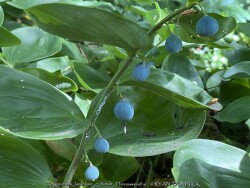

Solomon Seal (Polygonatum sp.) is a very large genus of perennials comprising dozens of species. Many of the species that are appropriate for garden use in Kansas are native to seasonally dry to moist forests in North America and Asia. New growth arises each year from a finger-like slowly spreading rhizome system. The foliage has a central stem with architecturally arranged opposite leaves covering the length of the stem gradually getting smaller towards the end. Small bell-shaped white flowers appear in early spring followed by bluish-purple fruit. Flowers and new spring growth is frost-hardy. Most Solomon seals do well with average garden soils and moisture with many tolerating dry-shade well. Solomon's seal can grow for many years increasing in density without ever needing division. Over time this creates a nearly weed-proof groundcover. in eastern Kansas with 40 inches of rain per year on average, there seems to be plenty of moisture to create extremely healthy patches of Solomon seal that compete well with tree roots. While some species can tolerate sun, there are many better choices as sunburning will likely occur with afternoon sun in temperatures over 95 degrees F. Combine with hostas or other shade plants to create a dramatic effect. Included in our "edibles" database but depends on how hungry you are! Wide-leaf Solomon's Seal (Polygonatum latifolium / hirtum 'Heronswood') is one of the most attractive solomon seals in our display garden. This species forms a tight clump of slow-spreading rhizomes with bubbly, shiny green foliage on stems 12" tall. Stems feature rows of small, white, clustered bells, attached just below the leaf intersections. Brilliant blue fruit ripens late summer and fall. Fall color is a brilliant yellow for a week before going dormant. Maintenance is easy as stems easily detach when raking with fall clean-up. If cosmetic foliage leaf-rust is a problem, just cut back early. A great "Once it's there, it's there forever" plant for dry-shade! Rarely available for sale as propagation is slow.
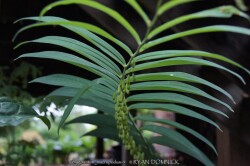

Solomon Seal (Polygonatum sp.) is a very large genus of perennials comprising dozens of species. Many of the species that are appropriate for garden use in Kansas are native to seasonally dry to moist forests in North America and Asia. New growth arises each year from a finger-like slowly spreading rhizome system. The foliage has a central stem with architecturally arranged opposite leaves covering the length of the stem gradually getting smaller towards the end. Small bell-shaped white flowers appear in early spring followed by bluish-purple fruit. Flowers and new spring growth is frost-hardy. Most Solomon seals do well with average garden soils and moisture with many tolerating dry-shade well. Solomon's seal can grow for many years increasing in density without ever needing division. Over time this creates a nearly weed-proof groundcover. in eastern Kansas with 40 inches of rain per year on average, there seems to be plenty of moisture to create extremely healthy patches of Solomon seal that compete well with tree roots. While some species can tolerate sun, there are many better choices as sunburning will likely occur with afternoon sun in temperatures over 95 degrees F. Combine with hostas or other shade plants to create a dramatic effect. Included in our "edibles" database but depends on how hungry you are! Big Footed Solomon's Seal (Polygonatum macropodum) is the largest and most architectural solomon seal in our display garden. This species forms a tight clump of slow-spreading rhizomes with symmetrical foliage upto 4' long. Stems feature long rows of small, white, clustered bells, attached just below the leaf intersections. Blue fruit ripens late summer and fall. Fall color is a brilliant yellow for a week before going dormant. Maintenance is easy as stems easily detach when raking with fall clean-up. If cosmetic foliage leaf-rust is a problem, just cut back early. During the April deep freeze of 2007, temperatures bottomed out at 18°F after an extra warm March. Hosta and Solomon seal foliage had completely unfurled and was flowering. All hostas were killed to the ground but solomon seal foliage and flowers survived un-damaged! A great "Once it's there, it's there forever" plant for dry-shade! Rarely available for sale as propagation is slow.
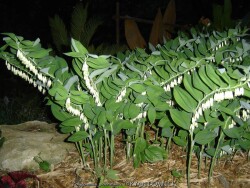

Solomon Seal (Polygonatum sp.) is a very large genus of perennials comprising dozens of species. Many of the species that are appropriate for garden use in Kansas are native to seasonally dry to moist forests in North America and Asia. New growth arises each year from a finger-like slowly spreading rhizome system. The foliage has a central stem with architecturally arranged opposite leaves covering the length of the stem gradually getting smaller towards the end. Small bell-shaped white flowers appear in early spring followed by bluish-purple fruit. Flowers and new spring growth is frost-hardy. Most Solomon seals do well with average garden soils and moisture with many tolerating dry-shade well. Solomon's seal can grow for many years increasing in density without ever needing division. Over time this creates a nearly weed-proof groundcover. in eastern Kansas with 40 inches of rain per year on average, there seems to be plenty of moisture to create extremely healthy patches of Solomon seal that compete well with tree roots. While some species can tolerate sun, there are many better choices as sunburning will likely occur with afternoon sun in temperatures over 95 degrees F. Combine with hostas or other shade plants to create a dramatic effect. Included in our "edibles" database but depends on how hungry you are! Medium Green Japanese Solomon's Seal (Polygonatum odoratum) adds a bright splash of light green to the shade garden. Fruiting does not occur on this variety like others. Height is uniformly 18-24" tall. Fall color is a brilliant yellow for a week before going dormant. Maintenance is easy as stems easily detach when raking with fall clean-up. If cosmetic foliage leaf-rust is a problem, just cut back early. During the April deep freeze of 2007, temperatures bottomed out at 18°F after an extra warm March. Hosta and Solomon seal foliage had completely unfurled and was flowering. All hostas were killed to the ground but solomon seal foliage and flowers survived un-damaged! A great "Once it's there, it's there forever" plant for dry-shade!
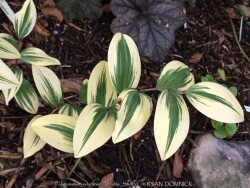

Solomon Seal (Polygonatum sp.) is a very large genus of perennials comprising dozens of species. Many of the species that are appropriate for garden use in Kansas are native to seasonally dry to moist forests in North America and Asia. New growth arises each year from a finger-like slowly spreading rhizome system. The foliage has a central stem with architecturally arranged opposite leaves covering the length of the stem gradually getting smaller towards the end. Small bell-shaped white flowers appear in early spring followed by bluish-purple fruit. Flowers and new spring growth is frost-hardy. Most Solomon seals do well with average garden soils and moisture with many tolerating dry-shade well. Solomon's seal can grow for many years increasing in density without ever needing division. Over time this creates a nearly weed-proof groundcover. in eastern Kansas with 40 inches of rain per year on average, there seems to be plenty of moisture to create extremely healthy patches of Solomon seal that compete well with tree roots. While some species can tolerate sun, there are many better choices as sunburning will likely occur with afternoon sun in temperatures over 95 degrees F. Combine with hostas or other shade plants to create a dramatic effect. Included in our "edibles" database but depends on how hungry you are! Double Stuff Variegated Solomon's Seal (Polygonatum odoratum 'Double Stuff') grows very slowly and is too weak to be sustainable in our garden: it is only included in our library as an interesting improved variegated type.


Solomon Seal (Polygonatum sp.) is a very large genus of perennials comprising dozens of species. Many of the species that are appropriate for garden use in Kansas are native to seasonally dry to moist forests in North America and Asia. New growth arises each year from a finger-like slowly spreading rhizome system. The foliage has a central stem with architecturally arranged opposite leaves covering the length of the stem gradually getting smaller towards the end. Small bell-shaped white flowers appear in early spring followed by bluish-purple fruit. Flowers and new spring growth is frost-hardy. Most Solomon seals do well with average garden soils and moisture with many tolerating dry-shade well. Solomon's seal can grow for many years increasing in density without ever needing division. Over time this creates a nearly weed-proof groundcover. in eastern Kansas with 40 inches of rain per year on average, there seems to be plenty of moisture to create extremely healthy patches of Solomon seal that compete well with tree roots. While some species can tolerate sun, there are many better choices as sunburning will likely occur with afternoon sun in temperatures over 95 degrees F. Combine with hostas or other shade plants to create a dramatic effect. Included in our "edibles" database but depends on how hungry you are! Ruby Slippers Solomon's Seal (Polygonatum odoratum 'Ruby Slippers') adds a bright splash of light green foliage and ruby-red stems to the shade garden. Height is uniformly 18-24" tall. Fall color is a brilliant yellow for a week before going dormant. Maintenance is easy as stems easily detach when raking with fall clean-up. A great "Once it's there, it's there forever" plant for dry-shade!
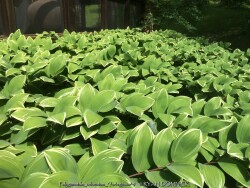

Solomon Seal (Polygonatum sp.) is a very large genus of perennials comprising dozens of species. Many of the species that are appropriate for garden use in Kansas are native to seasonally dry to moist forests in North America and Asia. New growth arises each year from a finger-like slowly spreading rhizome system. The foliage has a central stem with architecturally arranged opposite leaves covering the length of the stem gradually getting smaller towards the end. Small bell-shaped white flowers appear in early spring followed by bluish-purple fruit. Flowers and new spring growth is frost-hardy. Most Solomon seals do well with average garden soils and moisture with many tolerating dry-shade well. Solomon's seal can grow for many years increasing in density without ever needing division. Over time this creates a nearly weed-proof groundcover. in eastern Kansas with 40 inches of rain per year on average, there seems to be plenty of moisture to create extremely healthy patches of Solomon seal that compete well with tree roots. While some species can tolerate sun, there are many better choices as sunburning will likely occur with afternoon sun in temperatures over 95 degrees F. Combine with hostas or other shade plants to create a dramatic effect. Included in our "edibles" database but depends on how hungry you are! Variegated Solomon's Seal (Polygonatum odoratum 'Variegatum') adds a bright splash of light green and cream color to the shade garden. Fruiting does not occur on this variety like others. Height is uniformly 18-24" tall. Fall color is a brilliant yellow for a week before going dormant. Maintenance is easy as stems easily detach when raking with fall clean-up. During the April deep freeze of 2007, temperatures bottomed out at 18°F after an extra warm March. Hosta and Solomon seal foliage had completely unfurled and was flowering. All hostas were killed to the ground but solomon seal foliage and flowers survived un-damaged! A great "Once it's there, it's there forever" plant for dry-shade!
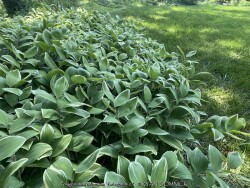

Solomon Seal (Polygonatum sp.) is a very large genus of perennials comprising dozens of species. Many of the species that are appropriate for garden use in Kansas are native to seasonally dry to moist forests in North America and Asia. New growth arises each year from a finger-like slowly spreading rhizome system. The foliage has a central stem with architecturally arranged opposite leaves covering the length of the stem gradually getting smaller towards the end. Small bell-shaped white flowers appear in early spring followed by bluish-purple fruit. Flowers and new spring growth is frost-hardy. Most Solomon seals do well with average garden soils and moisture with many tolerating dry-shade well. Solomon's seal can grow for many years increasing in density without ever needing division. Over time this creates a nearly weed-proof groundcover. in eastern Kansas with 40 inches of rain per year on average, there seems to be plenty of moisture to create extremely healthy patches of Solomon seal that compete well with tree roots. While some species can tolerate sun, there are many better choices as sunburning will likely occur with afternoon sun in temperatures over 95 degrees F. Combine with hostas or other shade plants to create a dramatic effect. Included in our "edibles" database but depends on how hungry you are! Variegated Solomon's Seal (Polygonatum odoratum 'Variegatum') adds a bright splash of light green and cream color to the shade garden. Fruiting does not occur on this variety like others. Height is uniformly 18-24" tall. Fall color is a brilliant yellow for a week before going dormant. Maintenance is easy as stems easily detach when raking with fall clean-up. During the April deep freeze of 2007, temperatures bottomed out at 18°F after an extra warm March. Hosta and Solomon seal foliage had completely unfurled and was flowering. All hostas were killed to the ground but solomon seal foliage and flowers survived un-damaged! A great "Once it's there, it's there forever" plant for dry-shade!
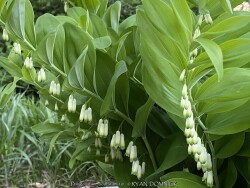

Solomon Seal (Polygonatum sp.) is a very large genus of perennials comprising dozens of species. Many of the species that are appropriate for garden use in Kansas are native to seasonally dry to moist forests in North America and Asia. New growth arises each year from a finger-like slowly spreading rhizome system. The foliage has a central stem with architecturally arranged opposite leaves covering the length of the stem gradually getting smaller towards the end. Small bell-shaped white flowers appear in early spring followed by bluish-purple fruit. Flowers and new spring growth is frost-hardy. Most Solomon seals do well with average garden soils and moisture with many tolerating dry-shade well. Solomon's seal can grow for many years increasing in density without ever needing division. Over time this creates a nearly weed-proof groundcover. in eastern Kansas with 40 inches of rain per year on average, there seems to be plenty of moisture to create extremely healthy patches of Solomon seal that compete well with tree roots. While some species can tolerate sun, there are many better choices as sunburning will likely occur with afternoon sun in temperatures over 95 degrees F. Combine with hostas or other shade plants to create a dramatic effect. Included in our "edibles" database but depends on how hungry you are!
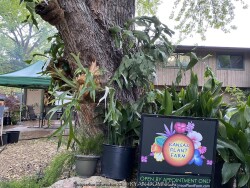

***Description for this plant available with future update!***Staghorn / Elkhorn Fern (Tropical), is also known as Platycerium bifurcatum
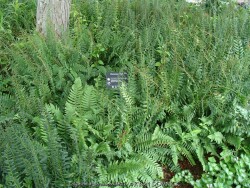

***Description for this perennial available with future update!*** Polystichum acrostichoides is also known as Christmas Fern >>>>>>>>>>>>is planted for its coarse, divided, triangular fronds in a medium green color. Native all continents in the Northern Hemisphere, it forms large colonies in forests with poor to average soil in sun to shade preferring sandy or peaty acidic soils. It colonizes medium to dry woodland areas, fields, old pastures, thickets, areas with disturbed soils, burned-out areas, and marsh edges. It can handle some Kansas drought in slightly acidic moisture-retentive soils but not full-on dry-shade. Foliage finally dies back to the ground in early autumn with "fiddle-heads" emerging and unfurling in mid-spring. Generally this plant holds its own in Kansas climates but fails to spread very quickly. Leaves can depreciate considerably in extremely hot weather and/or too much sun, particularly if soils are allowed to dry out to extremely. Root rot may occur in wet, poorly drained soils. With proper siting, it can be a "Once it's there, it's there forever" plant! I have seen an established planting thriving on the north side of a house for 20 plus years in Lawrence, KS.
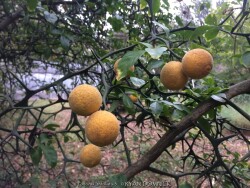

Hardy Orange (Poncirus trifoliata) makes an extremely architectural, well-branched, deciduous shrub with numerous thorns reminding me of the Sleeping Beauty Thorn Forest. One of the hardiest close relative of Citrus, Poncirus trifoliata in native to China and Korea. Hardy Orange makes an excellent privacy hedge for background areas away from foot traffic. Although deciduous, plants grow so dense that is virtually impenetrable. Also effective as an accent specimen in the sense of being an interesting and unusual. The root stock is used for grafting in the citrus industry. Growth requirements are simple; plant in almost any soil in full sun to full shade. As for ornamental qualities, these shrubs are covered with aromatic white flowers in spring followed by "edible" green fruits that turn yellowish orange by fall. Fruits of this citrus relative are edible with a strong lemony flavor but are very acidic and seedy. Fruits can used to make marmalade or left on the shrub where they persist well into winter providing significant ornamental interest. Growth is more open in shade with less flowering and fruits. It survived -16 degrees F and a week of single digit highs in February, 2021 after regrowing from the ground. Oklahoma State University in Stillwater, OK once had dozens of sidewalks lined with trifoliate orange pruned into long perfectly shaped 4'x4' rectangular cuboid. The woody growth was so dense that one could stand on top of this hedge; I personally witnessed this with amazement.


Hardy Orange (Poncirus trifoliata 'Flying Dragon') makes an extremely architectural, well-branched, deciduous shrub with numerous thorns reminding me of the Sleeping Beauty Thorn Forest. One of the hardiest close relative of Citrus, Poncirus trifoliata in native to China and Korea. Hardy Orange makes an excellent privacy hedge for background areas away from foot traffic. Although deciduous, plants grow so dense that is virtually impenetrable. Also effective as an accent specimen in the sense of being an interesting and unusual. The root stock is used for grafting in the citrus industry. Growth requirements are simple; plant in almost any soil in full sun to full shade. As for ornamental qualities, these shrubs are covered with aromatic white flowers in spring followed by "edible" green fruits that turn yellowish orange by fall. Fruits of this citrus relative are edible with a strong lemony flavor but are very acidic and seedy. Fruits can used to make marmalade or left on the shrub where they persist well into winter providing significant ornamental interest. Growth is more open in shade with less flowering and fruits. Oklahoma State University in Stillwater, OK once had dozens of sidewalks lined with trifoliate orange pruned into long perfectly shaped 4'x4' rectangular cuboid. The woody growth was so dense that one could stand on top of this hedge; I personally witnessed this with amazement. In our trial gardens in Lawrence, KS (zone 6a), a well established specimen planted 15 years ago survived -17 degrees F with no damage. Poncirus trifoliata 'Flying Dragon' is a beautiful contorted form of this plant that can best be described as a living piece of sculpture with its weaving branches and twisted thorns. Growth is much slower than the species. During the arctic blast of February, 2021, lows down to -17 degrees F on Feb 16th, 2021 were recorded. The longevity of this cold blast was also impressive: 10 days on a row with highs of 10-15 degrees F or lower, 8 nights of lows in the single digits and negatives, and 36 straight hours of 0 degrees F and mostly lower.
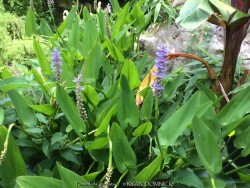

***Description for this water plant available with future update!*** Pontederia cordata is also known as Pickerel / Water Plant >>>>>This plant is usually grown as a bog plant needing constantly moist soil rich in organic matter. As a rain garden plant, it will thrive is a depressed area in the landscape that collects rain water from a roof during spring and summer periods of rain but then go dormant if the water hole dries out completely. For the home garden, the species is generally too aggressive to mix with other plants
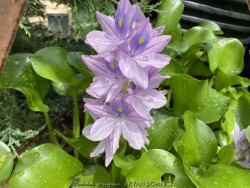

***Description for this water plant available with future update!***>>>>>Water Hyacinth (Tropical), is also known as Pontederia crassipes
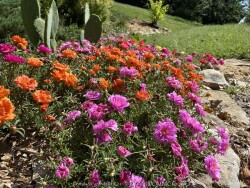

***Description for this plant available with future update!*** Portulaca grandiflora is also known as Mixed Rose Moss (Tropical).
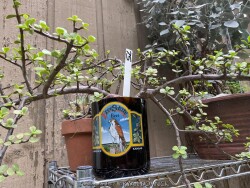

***Description for this plant available with future update!*** Portulacaria afra is also known as Elephant Bush (Tropical)>>>>>> Listed as Edible like other members in the portulaca family
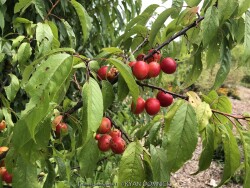

***Tree descriptions available with future update!*** Prunus americana is also known as American Plum
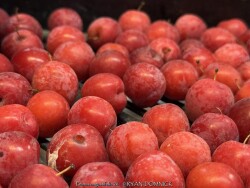

***Shrub descriptions available with future update!***Native Edible Sand Plum, is also known as Prunus angustifolia
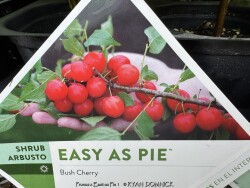

They say life is just a bowl of cherries...and Easy As Pie bush cherry (Prunus x) will give you bowls and bowls of fresh fruit every summer without any spraying or fussy pruning. This is an easy-going, easy-growing bush cherry that takes up just a fraction of the space as a cherry tree but produces abundant crops of very juicy, very tart cherries. It also has none of the disease issues that plague cherry trees, making it an easy choice for any sunny spot in a landscape or garden. Plant one as a standalone, as no pollinator is needed, or imagine an edible hedge with enough fruit for cooking, baking, and canning. White flowers in spring and vivid yellow and orange fall foliage keep it interesting all season long. All Proven Winners® plants are legally propagated, healthy and vigorous, true to name, and tagged with color pictures and growing information.
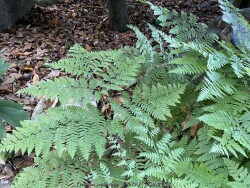

Bracken Fern (Pteridium aquilinum) is planted for its coarse, divided, triangular fronds in a medium green color. Native to all continents in the Northern Hemisphere, it forms large colonies in forests with poor to average soil in sun to shade preferring sandy or peaty acidic soils. It colonizes medium to dry woodland areas, fields, old pastures, thickets, areas with disturbed soils, burned-out areas, and marsh edges. It can handle some Kansas drought in slightly acidic moisture-retentive soils but not full-on dry-shade. Foliage finally dies back to the ground in early autumn with "fiddle-heads" emerging and unfurling in mid-spring. Generally this plant holds its own in Kansas climates but fails to spread very quickly. Leaves can depreciate considerably in extremely hot weather and/or too much sun, particularly if soils are allowed to dry out to extremely. Root rot may occur in wet, poorly drained soils. With proper siting, it can be a "Once it's there, it's there forever" plant! I have seen an established planting thriving on the north side of a house for 20 plus years in Lawrence, KS.
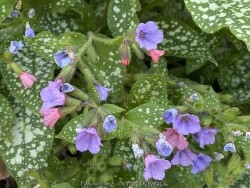

Lungwort (Pulmonoria saccharata) is planted for its unusual evergreen spekled white and green foliage. Foliage maintains well all summer provided that basic cultural conditions are met. Late spring flowers are a bright and colorful mix of blue, purple, and pink on the same plant changing colors as they age. Flowering last about 3-4 weeks and requires no dead-heading as new foliage swallows up dying flower stalks. Native to Europe, it slowly colonizes forests in humusy, medium well-drained soil in part shade to full shade. It can handle a little Kansas drought in in moisture-retentive soils but not full-on dry-shade. Foliage will flatten to the ground during drought then spring back up when moisture is available again. If low temperatures hit 0 degrees F, foliage finally dies back to the ground and re-emerges in early spring. Generally this plant holds its own in Kansas climates but fails to spread much. Leaves can depreciate considerably in extremely hot weather and/or too much sun, particularly if soils are allowed to dry out. Root rot may occur in wet, poorly drained soils. It is worth a try if you have a small spot to fill in a well-tended shade gardens.
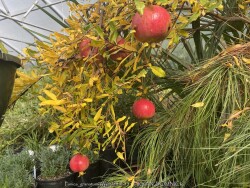

***Description for this plant available with future update!***Hardy Pomegranite (Tropical), is also known as Punica granatum 'Wonderful'
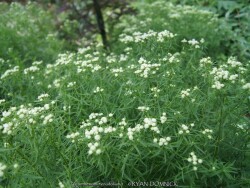

***Description for this perennial available with future update!***Narrow-Leaf Mountain Mint, is also known as Pycanthemum tenuifolium